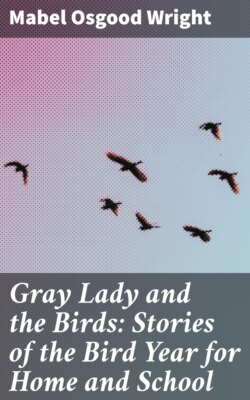Читать книгу Gray Lady and the Birds: Stories of the Bird Year for Home and School - Mabel Osgood Wright - Страница 10
На сайте Литреса книга снята с продажи.
The Fall Migration
ОглавлениеTable of Contents
“If you watch the birds, you will soon notice that some eat only animal food, in the shape of various bugs, worms, and lice, while others eat seeds of various weeds, and grasses, and also berries. There are many birds that, like ourselves, eat a little of everything, both animal and vegetable.
“For instance, the Swallows live on insects of the air, except sometimes in the autumn flocking they feed for a short time on bayberries. The Phœbe is an insect eater; also the Catbird, though he is fond of strawberries and cherries for dessert. You saw just now that the Chickadee, Woodpecker, and Jay preferred the meat from the sandwich and the Robins the berries from the pie, though the Jay also likes nuts and seeds.
“You know that when frost comes, the air-flying insects are killed, and the gnats, mosquitoes, and flies that have worried the horses and cattle disappear. For this reason the birds that depend upon these bugs must follow their food supply, and move off farther southward where frost has not yet come.
“This is the reason why so many birds who feed on winged insects leave us in early autumn, before it is cold enough to make them uncomfortable; they must follow their food.
“There are other birds that, when they no longer have nestlings to feed, can pick up a living from berries and seeds, like the Robin, or live the greater part of the season upon seeds, like the Sparrows. These birds are not driven away by the first frost, but many stay about until the weather is uncomfortably cold, and some few remain all winter, like the Meadowlarks, Nuthatches, Jays, and Woodpeckers, who, having stout beaks, can dig out grubs and insects from among the roots of grass and from tough tree bark; but these too must move on if ice coats the trees or snow buries their ground feeding-places.
“As a great many birds spend the nesting season north of New England, they pass by on their way southward, and, if the feeding is good, stay with us sometimes several weeks, so that the flocks of Robins seen here in October are likely to be those that nested in the north, while our own birds are gradually drifting down to the extreme south, where they winter.
“This great southward journey of the birds, that begins as early as August and lasts at some seasons, if the winter is open, almost until Christmas, is called the fall migration, and when it is over, the birds remaining with us are classed as Winter Residents.
“There is another thing to be seen at this time of year, and if you have not already noticed it, watch and you will see that many of the birds that wore bright feathers in May and June have changed their gay coats for duller feathers.
